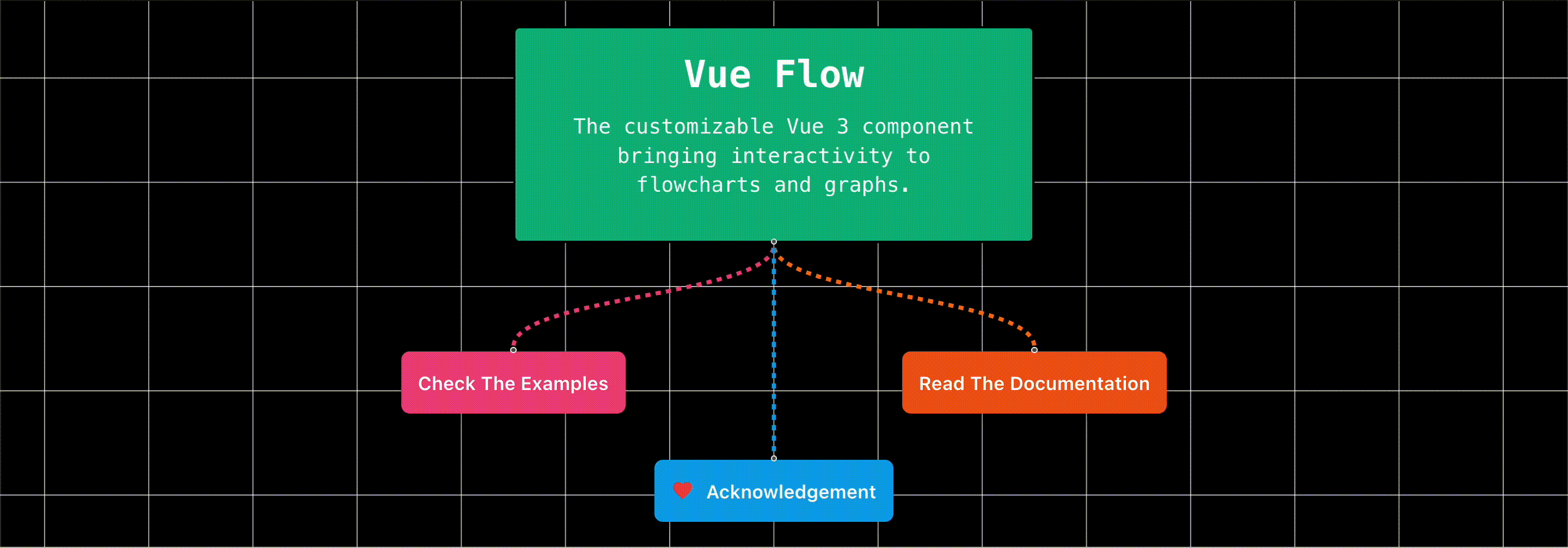8. auto layout
ROS2에 대해 알아보자
8. auto layout
Auto Layout
- vue-flow내 생성된 node/edge 정보를 토대로 수직 또는 수평으로 Layout Align을 맞추는 기능
사용 방법
- Version1, 중첩된 노드를 고려하지 않음(Nested Node auto layout 지원 x)
- Node/Edge의 경우 dagre 라이브러리를 사용하여 그래프 객체를 사로 만들고, useVueFlow fitView action을 사용하여 auto layout 수행 ( Node/Edge position을 잡기위해 dagre를 사용하는 것으로 보이나 동작 원리는 추가 분석 필요 )
1
2
3
4
5
6
7
8
9
10
11
12
13
14
15
16
17
18
19
20
21
22
23
24
25
26
27
28
29
30
31
32
33
34
35
36
37
38
39
40
41
42
43
44
45
46
47
48
49
50
51
52
53
54
55
56
57
58
59
60
61
62
63
64
65
66
67
68
69
70
71
72
73
74
75
76
77
78
79
80
81
82
83
84
85
86
87
88
89
90
91
92
93
94
95
96
97
98
99
100
101
102
103
104
105
# useLayout.js
import dagre from '@dagrejs/dagre'
import { Position, useVueFlow } from '@vue-flow/core'
import { ref } from 'vue'
/**
* Composable to run the layout algorithm on the graph.
* It uses the `dagre` library to calculate the layout of the nodes and edges.
*/
export function useLayout() {
const { findNode } = useVueFlow()
const graph = ref(new dagre.graphlib.Graph())
const previousDirection = ref('LR')
function layout(nodes, edges, direction) {
// we create a new graph instance, in case some nodes/edges were removed, otherwise dagre would act as if they were still there
const dagreGraph = new dagre.graphlib.Graph()
graph.value = dagreGraph
dagreGraph.setDefaultEdgeLabel(() => ({}))
const isHorizontal = direction === 'LR'
dagreGraph.setGraph({ rankdir: direction })
previousDirection.value = direction
for (const node of nodes) {
// if you need width+height of nodes for your layout, you can use the dimensions property of the internal node (`GraphNode` type)
const graphNode = findNode(node.id)
dagreGraph.setNode(node.id, {
width: graphNode.dimensions.width,
height: graphNode.dimensions.height,
})
console.log(graphNode)
console.log(dagreGraph)
}
for (const edge of edges) {
dagreGraph.setEdge(edge.source, edge.target)
}
dagre.layout(dagreGraph)
// set nodes with updated positions
return nodes.map((node) => {
const nodeWithPosition = dagreGraph.node(node.id)
return {
...node,
targetPosition: isHorizontal ? Position.Left : Position.Top,
sourcePosition: isHorizontal ? Position.Right : Position.Bottom,
position: { x: nodeWithPosition.x, y: nodeWithPosition.y },
}
})
}
function arrangeNode(nodes, edges) {
// we create a new graph instance, in case some nodes/edges were removed, otherwise dagre would act as if they were still there
const dagreGraph = new dagre.graphlib.Graph()
graph.value = dagreGraph
dagreGraph.setDefaultEdgeLabel(() => ({}))
dagreGraph.setGraph({ rankdir: 'TB' })
for (const node of nodes) {
// if you need width+height of nodes for your layout, you can use the dimensions property of the internal node (`GraphNode` type)
const graphNode = findNode(node.id)
dagreGraph.setNode(node.id, {
width: graphNode.dimensions.width || 150,
height: graphNode.dimensions.height || 50,
})
}
for (const edge of edges) {
dagreGraph.setEdge(edge.source, edge.target)
}
// set nodes with updated positions
return nodes.map((node) => {
return {
...node,
}
})
}
return { graph, layout, previousDirection, arrangeNode }
}
# main
async function layoutGraph(direction) {
await stop()
nodes.value = layout(nodes.value, edges.value, direction)
nextTick(() => {
fitView()
})
}
Version2, 중첩된 노드를 고려한 Layout 정렬
- Nested Node인 경우를 고려한 Auto Layout
- Nested Node의 경우 노드 좌표는 부모 노드의 상대좌표로 환산 되어야함
x = child.x - parent.x; y = child.y - parent.y
Ref. https://github.com/xyflow/xyflow/discussions/2968
- 부모-자식 노드 관계를 고려하여 Tree를 만들고 재귀호출 탐색(DFS)으로 layout도 정렬이 가능하지만, dagre-d3의 cluster 기능을 활용하여 x/y/width/height 값을 받아오고,
- 자식 노드일 경우는 부모 노드 좌표로 환산하여 업데이트 수행
# useLayout.js
import dagre from '@dagrejs/dagre'
import * as dagreD3 from 'dagre-d3'
import { Position, useVueFlow } from '@vue-flow/core'
import { ref } from 'vue'
export function useLayout() {
const { findNode } = useVueFlow()
const graph = ref(new dagre.graphlib.Graph())
const previousDirection = ref('LR')
function layout(nodes, edges, direction) {
const dagreGraph = new dagreD3.graphlib.Graph({ compound: true })
.setGraph({})
.setDefaultEdgeLabel(function () {
return {}
})
graph.value = dagreGraph
dagreGraph.setDefaultEdgeLabel(() => ({}))
const isHorizontal = direction === 'LR'
dagreGraph.setGraph({ rankdir: direction, ranksep: 10 })
previousDirection.value = direction
for (const node of nodes) {
const graphNode = findNode(node.id)
dagreGraph.setNode(node.id, {
width: graphNode.dimensions.width,
height: graphNode.dimensions.height,
})
}
for (const edge of edges) {
dagreGraph.setEdge(edge.source, edge.target)
}
const groupNodes = nodes.filter((node) => node.parentNode)
for (const groupNode of groupNodes) {
dagreGraph.setParent(groupNode.id, groupNode.parentNode)
}
dagre.layout(dagreGraph)
return nodes.map((node) => {
const nodeWithPosition = dagreGraph.node(node.id)
if (node.parentNode) {
const parentNode = dagreGraph.node(node.parentNode)
return {
...node,
targetPosition: isHorizontal ? Position.Left : Position.Top,
sourcePosition: isHorizontal ? Position.Right : Position.Bottom,
computedPosition: {
x: nodeWithPosition.x - nodeWithPosition.width / 2,
y: nodeWithPosition.y - nodeWithPosition.height / 2,
},
position: {
x:
nodeWithPosition.x - nodeWithPosition.width / 2 - parentNode.x + parentNode.width / 2,
y:
nodeWithPosition.y -
nodeWithPosition.height / 2 -
parentNode.y +
parentNode.height / 2,
},
style: {
width: `${nodeWithPosition.width}px`,
height: `${nodeWithPosition.height}px`,
},
}
} else {
return {
...node,
targetPosition: isHorizontal ? Position.Left : Position.Top,
sourcePosition: isHorizontal ? Position.Right : Position.Bottom,
computedPosition: {
x: nodeWithPosition.x - nodeWithPosition.width / 2,
y: nodeWithPosition.y - nodeWithPosition.height / 2,
},
position: {
x: nodeWithPosition.x - nodeWithPosition.width / 2,
y: nodeWithPosition.y - nodeWithPosition.height / 2,
},
style: {
width: `${nodeWithPosition.width}px`,
height: `${nodeWithPosition.height}px`,
},
}
}
})
}
function arrangeNode(nodes, edges) {
const dagreGraph = new dagre.graphlib.Graph()
graph.value = dagreGraph
dagreGraph.setDefaultEdgeLabel(() => ({}))
dagreGraph.setGraph({ rankdir: 'TB' })
for (const node of nodes) {
const graphNode = findNode(node.id)
dagreGraph.setNode(node.id, {
width: graphNode.dimensions.width || 150,
height: graphNode.dimensions.height || 50,
})
}
for (const edge of edges) {
dagreGraph.setEdge(edge.source, edge.target)
}
return nodes.map((node) => {
return {
...node,
}
})
}
return { graph, layout, previousDirection, arrangeNode }
}
This post is licensed under
CC BY 4.0
by the author.
